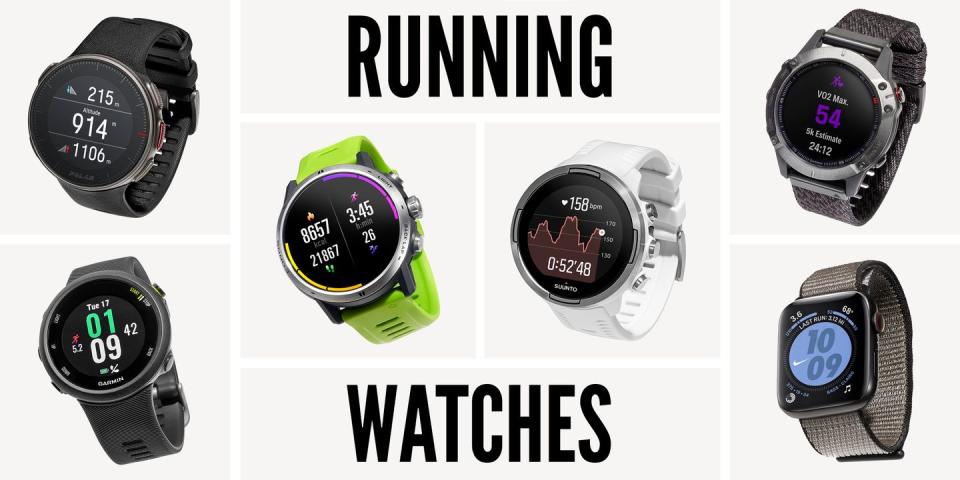The best GPS running watches for every type of runner

You put a lot of hard work into your running, so it makes sense that you'd want to track each stride, record every metric and analyse your insights to keep an eye on your progress. The obvious solution? A GPS running watch.
The best GPS running watches to buy in 2023 - quick links
Ready to record every metric and smash those PBs? Here's our edit of the best GPS running watches available to shop now. Keep scrolling for our full reviews.
How to choose the best GPS watch for running
While a GPS watch can benefit all runners, someone who is training for their first 10k is going to have slightly different needs to a seasoned ultra-marathoner.
Training features: Even the most basic running watches usually come with GPS sensors, step counters and heart rate monitors built-in. The likes of the Garmin Forerunner 55 also comes with Garmin Coach, which features adaptive training plans, daily suggested workouts based on your recovery, and cadence alerts to help with improvements in form. But the more premium the watch, the more training feedback you'll generally receive, including things like training readiness scores and endurance scores.
Extra features: If you don’t like taking your phone with you while you run, more premium options also come with offline music and contactless payments, so you can pick up a post-run snack or supplies on route.
Battery life: Affordable options like the Forerunner 55 still have a decent battery life, but generally speaking (asides from the Apple Watch), the more you have to spend, the better the battery life will be. The likes of the Polar Grit X Pro offer 40 hours of run timing using GPS, while the Garmin Fenix 7 lasts up to 73 hours in GPS mode.
Fit: If you’re a more petite build, you’ll want something that fits neatly on your wrist, so consider the size of the watch face. No one wants a strap that causes discomfort either. Plus, more hardcore watches built for trail running and multi-day adventures tend to be more rugged in appearance, so if you’re planning on wearing your watch 24/7, including at work, you might want something a bit more paired-back design wise.
Smartwatch vs running watch: Do you plan on wearing your running watch all day, every day, or do just want something you can strap on for training sessions? If it's the former, you'll want something more in the smartwatch realm, like the Garmin Venu, Epix, Fenix 7 or even an Apple Watch. The Forerunner fits the bill for training alone - although the latest Forerunner 965 does bridge the gap from running to smartwatch. Polar's Vantage V2 and the Coros Apex 2 also lean themselves towards being serious training tools.
How we test
We've tested and reviewed the leading GPS-running watches on the market. We've put them through their paces at parkruns and ultra races, in urban settings and in remote environments, and in all weather conditions. They've been used as coaches and as stopwatches, the many features explored to see if they're useful or not worth your investment.
The best running watches for 2023
Garmin Forerunner 265
Our top pick overall, the Forerunner 265 gives you pretty much everything you’d want in a running watch: a wide range of features, a decent battery life (up to 15 days), accurate tracking and customisable workouts – all without costing as much as Garmin’s flagship bands.
It’s the newest kid on the block too, replacing the 255 and 245 models. While the original is by no means bulky, it also comes in a smaller size for those who want an even lighter wrist companion. It’s got a sharp, colourful display that’s easily bright enough to work for outdoor runs on sunny days.
The Forerunner 265 is pretty hardcore when it comes to features too. It’s got the usual GPS, sleep tracking and fitness modes, but there’s also training status, training readiness and performance condition, which makes this feel like a real athlete’s watch. Our tester found the GPS quick to connect, and it didn’t lose its signal once during testing.
What separate this from the bigger boys like the Fenix 7 and Enduro 2 is the lack of maps and smart assistant – but for most people this won’t be a dealbreaker, and the large suit of features will more than suffice.
Garmin Forerunner 55
If you’re just starting out and want to make the step up from smartphone tracking apps to a running watch, the Forerunner 55 fits the bill. It comes with all the basics, including built-in GPS and optical heart rate monitoring, plus 20 hours’ GPS run time on a single charge and a general usage battery life that’ll get most runners through at least a week’s training.
It’s small, light and comfortable and though the small screen isn’t as easy to read or as luxe as pricier watches, the display does a good enough job in most light conditions.
Unsurprisingly, you don’t get the full suite of training features here, but the Forerunner 55 still has enough tools to cater for a wide range of running needs, with plenty of features geared towards the less experienced. This includes five running modes with track running and a virtual running mode for use with platforms like Zwift, plus Garmin Coach adaptive training plans, daily suggested workouts based on your recovery, handy GPS-based pace guidance for a selected course, cadence alerts to help with improvements in form and recovery advisor for advice on managing your rest between training efforts.
Beyond the run, you also get fitness, stress and body battery energy level tracking. The 55 will also estimate your fitness age - if you dare to look. And there’s women’s health tracking covering menstrual cycle and pregnancy. There’s music controls but no offline music - you’ll need to higher up the Garmin food chain for that and for things like Garmin Pay and other smart features which are missing here too.
Kiprun GPS 900
Decathlon’s Kiprun range is all about reliable running gear on a budget, and the GPS 900 – powered by Coros – definitely punches above its price tag. It’s a good option for anyone looking for a capable running partner on a tighter budget, offering more than your regular budget running watches with a simplicity that’ll suit beginner runners.
The 35-hour full GPS battery life extends to 80 hours in Ultramax low-power mode. That outlasts much pricier watches like the new Garmin Forerunner 965 and even the older Fenix 6 watches.
The Kiprun boasts Coros’ impressive suite of training tools, with performance, recovery and activity insights, including running performance, VO2 Max estimates, training load, impact and fatigue feedback.
Navigation functions stretch to breadcrumb route following, off-route alerts and back-to-start guidance. There’s a barometric altimeter for altitude and elevation tracking, too.
You also get smartphone notifications. However, you’re sacrificing bells and whistles like offline music and contactless payments – this is a watch for under £200, after all.
Polar Grit X Pro
The successor to Polar’s ruggedised, trail-friendly Grit X, the good-looking Grit X Pro offers all of the running, training and recovery features you find on its top-end watches like the Vantage V2, just in a more hench frame.
It also adds a suite of extra navigation tools for tackling more adventurous runs. You get reliable turn-by-turn navigation, with route planning powered by the excellent Komoot. Elevation profiles show you what awaits on the road and trails ahead. Great if you’re racing trail ultras. There’s also TrackBack to guide you back home safely following the route you’ve just run.
You get 40 hours of run time using full GPS and built-in optical heart rate. That extends to 100 hours in low-power mode. On paper that battery life is good but not quite Garmin Enduro or COROS Vertix 2 top-class. And in practice, the Grit X Pro drains a little faster than we’d like.
Polar’s sleep and recovery tools are still the best in business and the Grit X Pro offers everything here including sleep stages, Recovery Pro and workout recommendations based on overnight recovery. It also offers the newer performance and muscle recovery tests, to help you chart trends in your progress and manage your training.
Durability is ramped up too, with a military-grade rating, a scratch-resistant sapphire display and water resistance to 100m. Though at 79g it’s one of the heavier watches and daintier wrists might find it a little chunky.
The GPS link-up was impressively rapid and with support for all the major satellite systems, we found it reliable in our tests. It also packs a barometric altimeter and compass to power those off-beat navigation features.
Throw in FuelWise fuelling recommendations, Hill Splitter automatic climb detection and music controls for Spotify and other music apps, and you’ve got arguably Polar’s best watch right now.
Coros Pace 3
If you're after impressive staying power, in-depth training features and accurate GPS, the Pace 3 is one of the best money-can-buy choices right now.
The latest model benefits from an improved heart rate reader with 5 LEDs and four light-detecting photosensors, which act a bit like cameras. There’s also a bigger and better battery life - 24 days daily use and 38 hours continuous GPS (compared with 20 days use and 30 hours GPS in the Pace 2). It's got dual-frequency GPS – the type found in higher-end Garmin watches and the Apple Watch Ultra, which stays impressively stable, even in high-rise urban environments.
There's also new mapping features, including a route planner where you can either build your own custom route or search for a destination and sync it to the watch within the Coros app, and turn-by-turn navigation.
The Pace’s range of advanced running analytics is impressive. On the latest model you can view Running Performance, Training Load, scores and pace ranges for Aerobic Endurance, Aerobic Power, Threshold, Anaerobic Endurance and Anaerobic Power, cadence, stride length, elevation and more within the Coros app. This is then compatible with a selection of third party running apps, including Strava and Apple Health. Plus, the Pace 3 comes with training plans and workouts if you're not following a plan already.
Sure, it is a bit plasticky, so if you're looking for a slightly more premium, all-day smartwatch, that could be a dealbreaker. Ultra and trail runners should probably look elsewhere too. But for everyone else – particularly those looking for a reliable running watch to use for their workouts – it's an excellent watch at a hard-to-beat price.
Garmin Enduro 2
Basically a Fenix 7 with a beefed-up battery life, this hard-wearing hulk of a multisport watch is built to handle offroad and ultrarunning adventures. It’s a hefty investment and is probably more watch than most runners really need. But if you’ve got the means, the Garmin Enduro’s game-changing battery life is mind-blowing.
On paper it claims an unrivalled 80-hour GPS run time – extendable up to 300 hours in endurance mode. That’s boosted by solar charging skills that harness the sun’s rays to boost the Enduro’s endurance. In our tests, the watch lasted an astonishing 30 days on a single charge, with 30 hours of indoor and outdoor GPS-tracked workouts. An eight-hour ultra, using full GPS, burned just 10%. That means, we’ll happily eat a run streak (like a full-month of hour-long efforts) between charges and survive multi-day ultras with ease.
It’s not all battery, though. The Enduro 2 offers Garmin’s complete suite of training tools and insights. That includes reliable heart rate and accurate GPS plus training effect, training load, recovery recommendations and training-session suggestions. Running modes include road, trail, ultra and indoor with trail-adjusted VO2-max estimates and a nifty ultra feature that splits out the time you spend dawdling at aid-station buffets.
Unlike the original Enduro, there’s downloadable maps too, which makes this newer version a better adventure watch. All these features come at a price though, with the Enduro 2 coming in at double the price of the Apple Watch Series 8. Worth considering if you’ll use the watch enough to make the spend worthwhile.
Polar Pacer Pro
This might just be Polar’s best value running watch. For under £300, it packs in many features you’ll find on the brand’s pricier watches into its lightweight 41g frame. And while you don’t get premium materials like titanium bezels, it still looks stylish with interchangeable straps and a sleek-looking frame.
With 35 hours of full GPS run time – extendable up to 100 hours in low-power modes – the battery life is pretty much unrivalled at this price. Only the slightly pricier COROS Apex gets near it. Though in our tests, we got slightly less than the billed 35 hours.
There’s also no touchscreen but the button controls are easy to use and nicely responsive. The display is noticeably brighter than previous Polar watches too, though not quite sharp and vibrant as an Apple Watch or a Garmin Epix.
But what makes the Pacer Pro really stand out is its comprehensive suite of running, training, racing and recovery features. It’s an impressive line-up with the newish running performance test and VO2 Max estimates, running index score that lets you see how you compare to other runners, race time predictor, running power on the wrist and Polar’s Training Load Pro training guidance tools. You also get all-systems satellite support, super-fast GPS link-up, a built-in barometer, turn-by-turn routes powered by Komoot, route elevation profiles and automatic climb detection.
Outside of training, the sleep stages and Nightly Recharge recovery tools are still some of the best you’ll find on any running watch. The only thing missing is Recovery Pro – the more advanced (and more reliable) chest strap-based orthostatic testing for monitoring your body’s response to training and daily stresses.
But for most runners, there’s enough here to make this a real contender and a big rival to the likes of the Garmin Forerunner 265 and COROS Pace.
Suunto 9
Suunto’s answer to the Garmin Fenix, this 81g chunky beast of a watch has a rugged build, adventure-proof durability and a suite of tools geared towards longer, wilder runs. There’s a large, knock-proof, sapphire crystal touchscreen display and 100m water resistance but the real headline is the battery life, which eats ultras for fun. You get 120 hours in ultra power save mode, 25 hours in performance mode and pre-run recommendations of which battery mode to use to ensure the watch goes the distance.
Other standout features include fused GPS and motion-sensor distance tracking for added pace/distance accuracy, plus barometric and GPS altitude for additional trail run-specific stats. There’s plenty for the regular runner too, such as guided interval sessions and heart rate zone training.
Beyond all that lurk a number of potential nasties. The screen needs to be brighter and sharper, and Suunto’s watch menus and controls are often baffling. You need to spend time learning the watch rather than being able to use it straight out of the box, and the partner app lacks the depth of stats, tools and analytics you get from those of other brands.
Garmin Instinct Solar 2
The Instinct often gets overlooked in ‘regular’ running watch line-ups because of its hardcore adventure credentials, but if you need a run tracker that can handle more extreme excursions than your local parkrun, the Instinct Solar 2 is worth considering.
This military-grade tracking tool is built for serious battles with the outdoors. It’s waterproof to 100m, thermal and shock resistant and has a scratch-resistant display and polymer-toughened case.
But beyond that rugged build, it’s also a capable all-around running tool on and off the road. Its excellent safety features, including incident detection and live location sharing, also make it well-suited to off-road ultras and exploration.
At 53g, it’s lighter and less bulky than a Fenix – almost a Garmin Fenix Lite with a similar styling – and ideal if you’ve got smaller wrists. Despite the smaller screen, stats are still perfectly legible on the move.
It’s also currently the cheapest watch to feature Garmin’s breakthrough solar-charging skills. In the right conditions, that ray-converting solar display can boost an already-competitive 30-hour GPS battery to 48 hours, and stretch the low-power mode from 70 up to 370 hours. We didn’t quite test the 370 hours but on full GPS, those numbers held up.
You also now get access to Garmin’s run-specific tracking, training and recovery tools including VO2 Max estimates, training status, training load, post-run training effect readings and recovery time recommendations. Plus suggested workouts, too.
The lack of maps is surprising on a watch like this but the navigation skills are still strong. You get turn-by-turn breadcrumb and back-to-start navigation, along with distance to destination and future elevation for routes you load onto the watch. That’s particularly useful for trail runs and races.
Music is limited to controls rather than offline playback but there is a ‘kill switch’ feature that instantly wipes the watch of all user data. You know, if things go really badly at your next city marathon.
Polar Vantage V2
The second-generation Vantage V2 is Polar’s most fully-featured watch, aimed squarely at serious performance chasers. Everything we liked in the popular original is still here and some things we didn’t have been fixed. That includes a more responsive touchscreen and button controls; a 14g lighter, almost one-piece sleek casing and softer, more comfortable silicone straps.
Staying power has improved too. On paper, the V2’s battery life is virtually unrivalled on watches under £500. Only the Coros Apex Pro and Polar’s own Grit X get near its 40-hour GPS run time – extendable up to 100 hours in low-power mode. And though it didn’t quite live up to that billing in our tests, it still packs more than enough endurance to suit most runners – even ultra fans.
The Vantage V2 tracks everything any sane runner could want. You get running power on the wrist, a Hill Splitter feature that breaks down your climb and descents stats and a heart-rate-intensity-based bonk-avoidance fuelling tool that tells you when to scoff carbs during longer runs.
It also comes with two unique new tests. A Running Performance Test recreates a lab-style, lung-busting maximal-effort fitness test and reveals your estimated VO2 max, your maximum heart rate and your important training threshold zones.
A watch-guided, jump Leg Recovery Test also reveals if your muscles are recovered, handy for helping you decide when to run again after heavier workouts.
Garmin Forerunner 745
The 745 is Garmin’s smallest and lightest (47g) triathlon-focused watch. It comes with all the swim, bike and run-training tools we’ve come to expect on a higher-end watch, including training effect, training load, VO2 max for runs and rides and recovery- time recommendations. Plus a performance condition tool that compares your current run performance, in real-time, to other recent efforts. However, many of these features rely on optical heart-rate readings that aren’t always on point.
Garmin has also added daily workout suggestions, based on your recent training history – useful if you’re not sure how to stitch together an effective training schedule. There are also goal-based adaptive training plans and familiar tools such as the running race predictor, though we’ve come to take its optimistic estimates with a big pinch of salt.
The 1.2-inch colour screen is bright and crisp and Garmin’s standard five-button controls – and shortcut menus – make it easy to control on the move and sift through your post-run data.
Overall, this is a well-built, highly capable watch with a surprisingly comprehensive mix of training, racing, navigation and smartwatch skills.
However, there’s a big caveat: the 16-hour GPS battery now seems poor compared with rivals at the same price, even though that extends up to 21 hours in UltraTrac mode. And that makes this a hard one to recommend, particularly if you’re training two or three hours a day.
Apple Watch Series 8
The Apple Watch Series 8 remains a smartwatch first and running watch second – but that’s not to say it doesn’t warrant a spot in our round-up. With calls, contactless payments, music and a gazillion other conveniences that work off its 4G connection, you’re getting a best-in-class selection of run-supporting tools that help with the stuff that happens beyond your daily plod.
The Series 8 is easily Apple’s best running tool to date, carrying forward everything we like from the Series 7, along with a new temperature sensor that we’ve found a real gamechanger for tracking our menstrual cycle. And if you’ve been wondering if a smartwatch can ever replace a ‘proper’ running watch, this is the closest we’ve come.
That’s in part thanks to reliable heart rate reliability and better GPS performance (with full systems satellite support) but you’re also getting a larger always-on screen that makes your stats easier to read at a glance – say through the pain of an interval session. Crucially without leeching battery life.
The single charge six-hour run time battery life is still a long way off your COROS and Garmin endurance watches but it’ll happily see most runners through a marathon. And the fact this generation fast charges in just 20 minutes means you can quickly juice it up, if you’re low when it’s time to run.
There are features here that your classic run watches don’t offer, too. Including automatic run tracking and the ability to send and receive data from treadmills. The Activity app also now makes it easier to chart your basic running progress with a 365-day view of your pace, distance and VO2 Max to reveal if you’re getting faster, going longer, and becoming fitter.
Garmin Fenix 7
The Fenix 7 is the total running tool. It packs Garmin’s most comprehensive suite of training, racing, fitness, wellness, navigation and smartwatch features. It now also boasts a bigger battery life, improved solar charging, a colour touchscreen and colour TOPO maps. Alongside existing features like suggested workouts, training effect and load feedback, recovery time recommendations, sleep tracking, phone-free music playback and contactless payments.
There’s new military-style multi-band GPS, designed to improve GPS accuracy in areas where regular signals can struggle. Though we didn’t find the all-systems multi-GNSS mode made that much difference.
You also get Stamina – which uses your training history and metrics like max HR and VO2 Max to provide a dynamic read on how much gas you’ve got left in the tank at different paces. All in a watch that’s built big, rugged and durable and eats up urban marathon training and wilder endurance adventures for fun.
You’ll get between 37-89 hours of GPS run time which extends up to an impressive 122 hours with the right power save modes on and good solar conditions. In our tests, an hour’s full GPS run burned just 2% and we’d used just 50% after 15 days wear with 10 hours of training. That’s not the best battery in the business, the COROS Vertix 2 goes longer, but it’s more than enough even for most multi-day ultras.
Speaking of which, the maps and route-following navigation skills will appeal to runners who explore unknown tracks and trails.
With three different case sizes 7S, 7 and 7X, plus standard, solar and solar sapphire editions, the Fenix 7 range features a huge range of designs and specs. And a wide price range. But for our money, the Fenix 7 Sapphire Solar offers the best bang-for-buck balance of size, features and staying power.
Coros Apex 2
If you regularly swap pavements for trails, the Apex 2 is another watch that’s built for long-haul off-road mileage but packs plenty for regular road runners too. Not least, the standout feature here: Coros’s trademark staying power, with up to 45 hours of full GPS use (that’s five more than the original Apex). Plus, it takes less than two hours for the watch to go from zero to full charge.
The Apex 2 comes ready to rumble with the mixed terrain, but tools like track mode – where you set your lane to tune up the GPS accuracy – interval session builder, pre-loaded training sessions and running power on the wrist, make this more than just a trail runner’s tool.
The Pro is sleeker than some adventure running watches. But despite being thinner and noticeably lighter than a Garmin Fenix 7, it’s still a chunk of a watch that can swamp smaller wrists.
That’s partly thanks to a tough, 1.2-inch sapphire glass, colour touchscreen that’s happy to take knocks and offers ample real estate for your stats. Under its rugged exterior, the Apex’s suite of sensors includes a barometric altimeter for real-time acclimatisation readouts and a compass to power turn-by-turn and back to start navigation.
With free global offline Landscape and Topographical maps, you can access critical navigation information in the most remote locations. The digital dial on the watch allows you to zoom in and out of your map too. GPS performance is strong, and the optical heart rate performs well on steady runs – though it can struggle to track higher intensity bursts during interval sessions or steep hill climbs, so training-insights data may be skewed.
Garmin epix Pro (Gen 2)
If you're used to one of Garmin's more affordable smartwatches like the Venu 2 Plus, the Garmin epix Pro will definitely feel like a step up in comparison. This is a running watch for front-of-the-pack runners – those who prefer more of a rugged build but don’t want to compromise on a super sharp display.
It has a crystal-clear AMOLED touchscreen display, a whole host of advanced training features on top of Garmin’s usual 24/7 health and wellness monitoring, a built-in LED flashlight for training in the dark and 30 new preloaded sport activities including basketball and horseback riding. If that wasn't enough, there's also new training features including ‘hill score’ – which measures your capability for running uphill and assesses your progress based on your VO2 Max estimate – and ‘endurance score’, which looks at your ability to sustain prolonged efforts.
There’s no beating around the bush here – this is an expensive watch. But the epix Pro does feature a whole load of impressive features – including an optimised heart rate sensor and new weather map overlays. So if you’re currently thinking about upgrading from an older Forerunner (or, indeed Venu), this really is an excellent smartwatch.
Coros Vertix 2
The Vertix 2 is COROS’ flagship running watch and a firm rival to the Garmin Fenix. Its stand-out feature is a mind-boggling 140-hour GPS battery life. But there’s more to this 91g rugged beast than endurance. It packs an altimeter, barometer and compass, all-systems dual frequency GPS for improved accuracy, offline TOPO maps, 32GB music storage and offline playback. Plus the brand new EvoLab suite of performance insights and training tools that puts COROS on a par with its rivals.
That includes real-time training load, VO2 Max, pace and intensity guidance, base fitness level, fatigue level, load impact and recovery time recommendations. It’ll also assess your running performance level, give you a marathon-level benchmark and predicted race times.
On paper, the Vertix 2’s 140 hours full GPS can be extended to 240 hours in UltraMax lower power mode. But drops to 50 h0urs when you turn on the All Systems GPS with Dual Frequency to squeeze out extra accuracy. And just 30 hours if you’re using music.
In our tests, where we ran a marathon a day for 7 days, the Vertix 2 lasted 2 weeks and 5 hours, including those seven marathons. That’s 189 miles and 30.5 hours of GPS running with some runs in the most draining All Systems + Dual Frequency Mode, all using optical HR and one also using music for 3 hours.
The Vertix 2’s large sapphire 280 x 280 pixel LCD 64-colour touchscreen display sits in a slick titanium alloy bezel and casing and there’s also an Electrocardiogram (ECG) Sensor built into the outer bezel for accurate Heart Rate Variability readings. Something you won’t find on any Garmin.
Oldies but goodies...
They're still for sale and worth considering.
Garmin Forerunner 245
The 255 and 265 might have been released since, but the trusty Forerunner 245 still holds a place in our hearts - and on our wrists.
It’s got a decent battery life that will see you through a week of training (24 hours with GPS mode), it’s packed with useful features you can use to optimise your running technique, and it's a sleeker, less-rugged design than some of Garmin's higher-end options.
In the 245, features such as body battery and running dynamics tracking evaluate your current training status to indicate if you’re undertraining or overdoing it. Garmin also offers additional performance monitoring features, so if you're a junkie for stats and analysis, you can get into the nitty gritty information that the watch stores after each workout.
There's no offline music (although the 245 with music is not much extra) or contactless payments, but you can get smartphone notifications. Sure, the screen looks a little outdated when you compare it to the newer 265 model, but it's still a solid training watch for many.
Garmin Fenix 6 Pro
With the 6S, the 6X and the Pro, the Garmin Fenix 6 range actually spans a whopping 19 different models, sizes and editions that start from £500 and go right up to £900. You pay extra for bigger, more robust cases, premium features like offline music, a longer battery life and also the solar-charging skills you find in the Instinct and the Enduro.
However, the sweet spot watch bang-for-back is really the Fenix 6 Pro and Sapphire. The latter not only packs those premium tools but has a diamond-like, carbon-coated bezel and case with a sapphire crystal display. It offers a 36-hour full GPS battery life, which extends to 72 hours in max-power mode. There’s no hiding the fact this is a chunky watch, but its large colour display can be customised on the watch to show up to six mid-run metrics at a time and brightens in direct sunlight, for easy reading. GPS tracking is reliable but the Fenix 6 falls down on heart rate accuracy compared to a chest strap. That can skew the huge array of running insights including heat - and altitude-adjusted VO2 max estimates, training effect and training load.
The Fenix’s navigation tools are also top notch with route planning, popular route mapping, back to start navigation and maps. If you’re racing in the mountains, ClimbPro also lets you know how much elevation awaits you and estimates your finish time based on your course and your current performance.
Garmin Forerunner 45
There's very little to quibble about with this watch. Sitting low on the GPS price scale, it does everything you need it to (and more) without setting you back the GDP of a medium-sized nation. It’s light and the display is big, bright and easy to read on the run. It’s simple to operate, with decent- sized buttons meaning no confused fumbling.
GPS lock was consistent, plus it detects movement without GPS lock and it will find satellites while you run. It has a wrist-based heart-rate sensor and the Garmin Coach tailored training plans are great; it's like having a mini-coach on your wrist.
It features the usual multisport functions as well as several wellness features, such as stress and body battery (energy) monitors.
To sum up, this is a hugely impressive piece of kit that offers runners incredible value for money.
Garmin Epix
We’ve been begging big sports watch brands to deliver us a fully-tooled up outdoors adventure running watch with a bright AMOLED, smartwatch-quality touchscreen display. But we wanted that sexy screen goodness without having to sacrifice battery life. Well now we have it.
The Epix is essentially a Garmin Fenix with a killer screen. It has the same robust and rugged design, carries virtually the same tech spec and a very similar comprehensive feature set. You will sacrifice maximum battery life for that pin-sharp window into your workouts and there’s no endurance-pushing solar charging. But with 42-hours full GPS run time and the option to tweak the power modes to extend that up to 75 hours, this is still a great endurance option.
In our tests we got around 8 days usage, including 10 hours training in the top GPS modes and the Epix will definitely give most runners at least a week’s mileage on a single charge.
It carries a Fenix-style comprehensive list of Garmin’s training, general activity and wellness and smartwatch features. You get the same optical heart rate tech that powers everything from training load, training effect and recovery time recommendations, to relatively reliable stress-based Body Battery reads, 24/7 heart rate monitoring and sleep tracking. There’s also breathing tracking and Pulse Oximetry for monitoring blood oxygen levels.
For those who want training guidance, there are suggested workouts based on recent activity, Garmin Coach adaptive training plans and animated workouts. You can chart fitness progress with VO2 Max estimates and helpful new trend charts that add useful context to the running race time predictions. Those predictions are still a tad pessimistic but seeing your trajectory is a welcome upgrade.
This brilliant tool is a do-it-all dynamo that comes close to being the perfect fitness and adventure package. Though you’d expect it for that big ‘ol price tag.
You Might Also Like

 Yahoo Sport
Yahoo Sport 





































